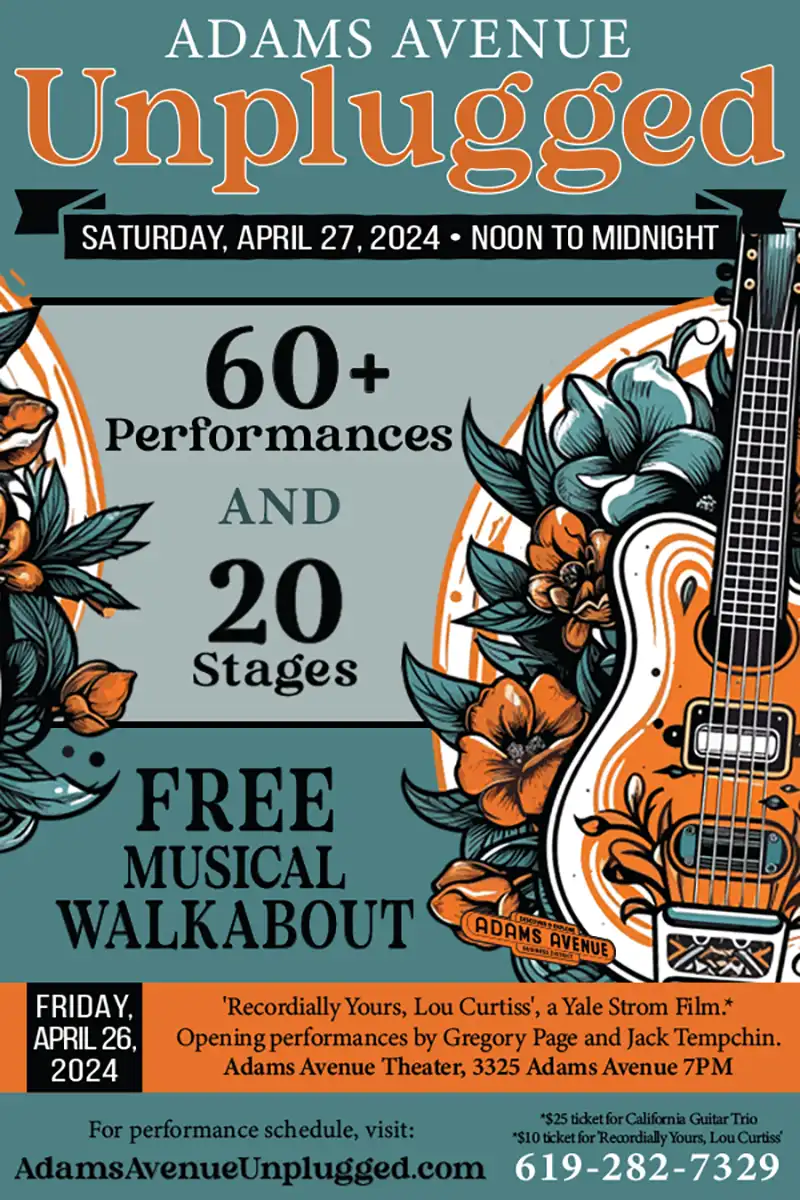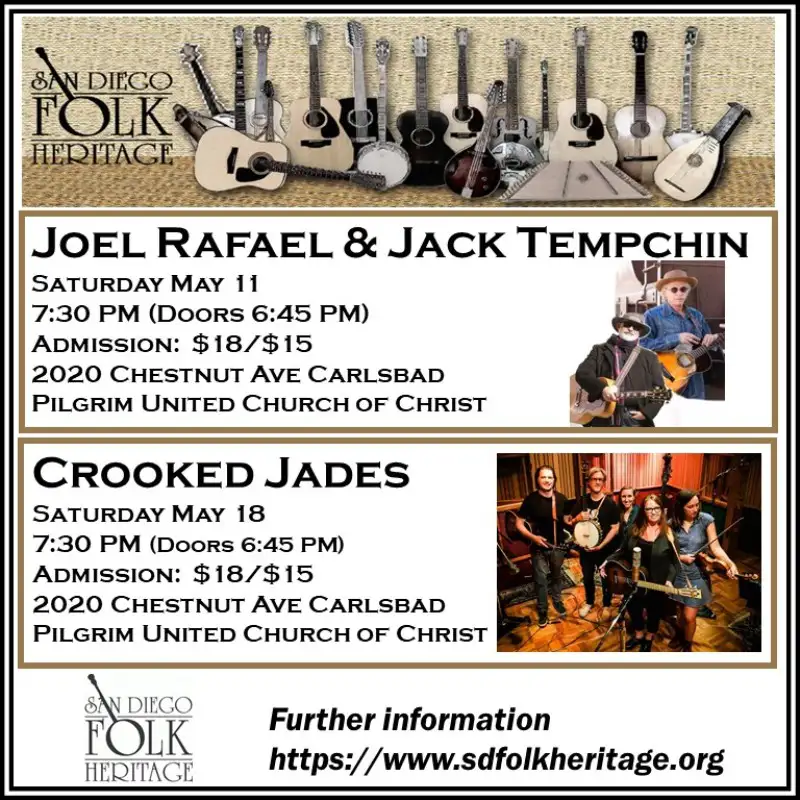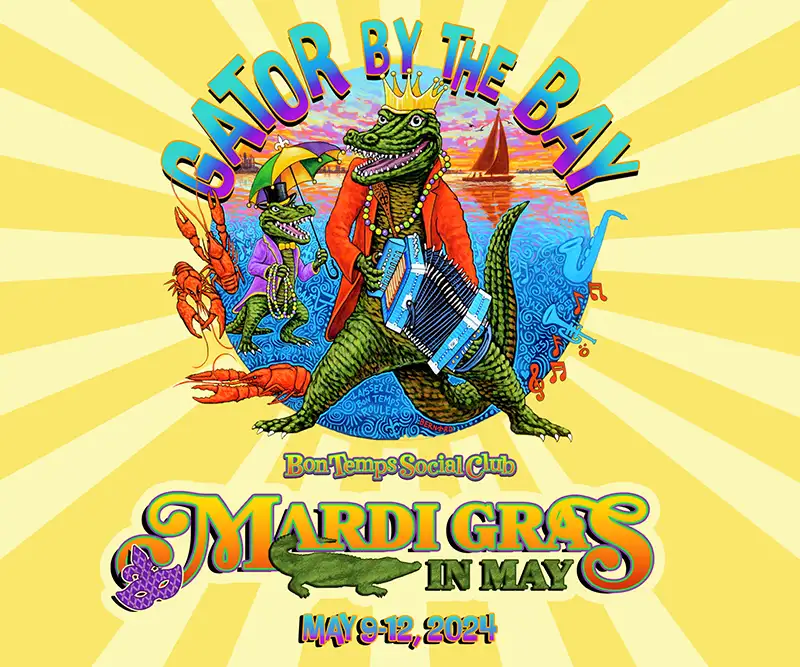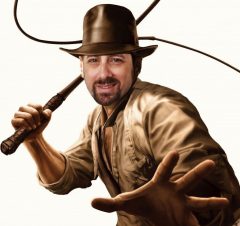Raider of the Lost Arts
The Drum Solo
The drummer propels the band into a hooky neo-blues riff. They go through the related chord changes until reaching the end of the head, when the band stops with a crash. The spotlight zeros in on the drummer and the other three leave the stage while he strikes out on his own. He starts subtly building up the dynamics over a minute or two before stopping again to put his sticks down and release the clutch on his snare drum. Suddenly, he’s hitting everything with his bare hands(!), occasionally pressing the drumheads in to raise the pitch like a well-nuanced conga player. He switches over to a set of bongos and other tuned exotic drums to his left for a minute. Then he picks up his sticks again and starts to lay in to a set of timpani, which get dramatically flanged through the PA. The wires are brought tight against the bottom of the snare once more, and he ramps it up with killer snare and tom work, arms a stunning blur, hirsute head whip-lashing, face wincing in the ecstatic rictus of technical exertion, hi-hat tapping unfalteringly all the while. The demonic triplet and quad roll fury build to an exhilarating crescendo, with the drummer crossing his arms over one another in a studied showman’s preternaturally rapid execution of pattern variations. He checks to make sure his bandmates have returned to their marks as he decelerates, and ends by playing the snare pattern intro to recapitulate the head. The riff concludes and the drummer tacks a little solo coda on before the band does a triumphant end flourish, with the drummer igniting a gong behind him via heavy hits from a flaming mallet. The crowd goes bananas.
Congratulations! It’s sometime during the heady 1970s, and you’ve just witnessed Led Zeppelin’s John Henry “Bonzo” Bonham––whom Rolling Stone declared the best drummer of all time––performing “Moby Dick,” his signature drum solo.
*************
Up until the early 20th century, the percussion section of a classical orchestra farmed out the various frequency elements (bass, snare, cymbals, and auxiliary) to individual players, and composers rarely gave them anything of import or duration to perform (thank goodness for Ravel’s Bolero). In our world cultures’ tribal traditions, only the hands were employed to hit various types of drums or use other percussion elements such as shakers and tambourines. Then, during the first few decades of the previous century, the advent of the kick drum pedal and the hi-hat freed up both hands of a single performer for the innovations that followed (mounted tom toms and percussion, and cymbals, snares, and other drums on stands). Thus, the trap kit as we know it came into being, putting all the flavors of the orchestra’s rhythm section at the disposal of a single drummer, who subsequently evolved into their own eccentric breed of polyphonic timekeeper.
At the onset, big bands and jazz combos took the drum kit and ran with it. In genres where solos got passed around to virtually every other instrument, it was only a matter of time before someone said, “Hey, might as well let the guy in the back get some.” Of course, there were other heroes before them, but Gene Krupa and Buddy Rich were two of the first notables to step forward and transform their solo turns into show-stopping entertainment spectacles, not only with their own groups but also in each other’s company (their epic drum battles, some of them staged for television, are the stuff of legend).
Jazz initially found predominantly understated heroes in the likes of Joe Morello, whose solos in the middle of “Take Five” and “Everybody’s Jumpin’” from the Dave Brubeck Quartet’s 1959 album Time Out (the first jazz album to sell a million copies) are maddeningly, enticingly restrained, as if he was gingerly fumbling through uncharted territory in the dark, or balking at the sanctioned violation of a drummer’s supporting-player directive, or both. Any jazz drummer leading an eponymous group was practically obligated to solo, as Art Blakey did, stretching out in the hard bebop sound that he helped to define through the combo that bore his name.
Rock ‘n’ roll wrested the drums from jazz in the mid-fifties and gave them up for skiffle and folk during the last few years of that decade. The early sixties saw a steady percolation of percussive prowess in the pop format via the first British invasion, with the impulse first subverted into the songs’ beats themselves (though even Ringo managed to work a short solo into “Hello Goodbye” and the Abbey Road medley). In the middle of that decade, we saw the rise of prodigies like Keith Moon and Ginger “Frog” Baker, who seemingly managed to make solos out of every song’s beats. The latter half of the sixties saw the rise of up-and-coming practitioners embracing the individualistic, something-to-prove imperative, led by the frenetic Mitch Mitchell (of Jimi Hendrix fame) and his jazz-on-PCP style. Bill Bruford also managed to carry the jazz tradition with him into the trailblazing Yes (he did an occasional solo live and got a chance to showcase on “5 Percent for Nothing” from the Fragile album), as did Tony Williams in the fusion realm, and Phil Collins in the prog and pop realms (obligatory lip service to what is arguably the most famous drum-fill of all time must be paid to his “In the Air Tonight”). The Grateful Dead’s Bill Kreutzman and Mickey Hart––aided and abetted by Butch Trucks and Jaimoe Johanson of the Allman Brothers––initiated proceedings under the two-is-better-than-one jam-band rubric. And then there was 19-year-old Mike Shrieve’s gobsmacking turn with the acid-tripping Santana at Woodstock, where he stole the whole show during “Soul Sacrifice.” The tradition finally found full fruition in the rock realm through the aforementioned master, the titanic John Bonham, who was arguably the one to definitively propel the drum solo into its own art form (though our hats must tip to pop songstress and who-knew drum hero Karen Carpenter, who bested Bonham in a 1975 Playboy poll!).
The ladies weren’t properly recognized until Sheila E(scovedo) stepped up and out with Prince during the ’80s. Her versatility on both a drum kit and a set of percussion-augmented timbales added a Latin spice to Prince’s R&B stew, heavily influencing his musical direction and opening the stage for subsequent crushers like Janet Weiss (Sleater Kinney), Meg White (The White Stripes), and Cindy Blackman Santana (Lenny Kravitz), wife of Carlos.
Neil Peart of Rush, who has sadly now been gone for over a year, picked up the baton in the mid-seventies and carried it all the way through the still-prevailing dark ages until his retirement in 2015 (every Rush show after the first tour or two featured him in his own segment). Along with Alex Van Halen, Peart was one of the last holdouts in a live rock context as showing off slowly fell out of fashion. His solos were both musical and technical, spanning a wide and exotic variety of acoustic and electronic percussion and keyboard-derived rhythm instruments, and were the paragon of sheer power, precision, and invention. He often dropped it somewhere in the middle of “YYZ,” one of several of Rush’s instrumentals; check out the version on their second live album, Exit, Stage Left, which is arguably one of the best solos ever recorded.
The ’70s and ’80s marked the rise of the ultra-technicians, drummers who would become widely known and respected through their gun-for-hire studio and touring work as well as entertainingly educational solo drum clinics. Terry Bozio got his start playing nigh into impossible composed parts with Frank Zappa’s Mothers of Invention, transitioned to new wave in Missing Persons, and eventually conquered the clinic world with the gargantuan Guinness-record-holding drum set he plays to this day. Studio aces like Steve Gadd, Vinnie Colaiuta, and Dave Weckl wended their separate ways up the session and touring ladders and came together for the ultimate bataille a trois as part of a Buddy Rich tribute concert on October 14, 1989 (Neil Peart was also on that bill, as was Dennis Chambers and other notables).
The onset of grunge effectively knocked the wind out of drumming’s solo sails starting in the early ’90s, sentencing it to the self-indulgently passé penalty box alongside the guitar and bass solo. Nevertheless, many Gen-X champions ably took the passed baton, albeit in a more restrained, song-serving manner; John Stainer (Helmet), Matt Cameron (Soundgarden, Pearl Jam), Jimmy Chamberlin (Smashing Pumpkins), Carter Beauford (Dave Matthews Band), Danny Carey (Tool), Dan Peters (Mudhoney), Brendan Canty (FUGAZI), and Tim “Herb” Alexander (Primus) all had the chops to exhibit but mostly kept their finesse hidden or camouflaged (although Alexander did manage to squeeze one in through the closing door, throwing down in the middle of “Jellikit” on Primus’ live-recorded 1989 debut, Suck on This…but when you’ve got bassist/frontman Les Claypool saying, “We’re Primus and we suck” during shows, the writing’s on the wall). If there were any contemporary drummers soloing during this past decade, it was happening in tradition-honoring, almost-but-not-quite-famous bands like Lake Street Dive, with Mike Calabrese as one of three accomplished soloists in the outfit, or through amazing but obscure young clinicians like Maison Guidry.
************
There was no way to maintain widespread public interest in rhythmic histrionics as popular focus slowly shifted away from real drum-based genres to whatever the hell it is we’re listening to now. The drum solo and its practitioners have gone underground, toiling away in the lingering jazz traditions and on clinic and NAMM stages in front of gray-pony-tailed audiences in music industry cities. Young up-and-comers––usually child prodigies––have to lean on fleeting novelty, look-at-me pyrotechnics, and/or covers of older famous artists’ material for their “brand visibility,” mostly sticking to the creation of fiscally nonviable video content for various online platforms and subsisting on a nutrient-poor approval diet of digital likes and subscribes. The drum solo is a relic of the glorious past, before drummers’ jobs were outsourced to beat boxes and MIDI VSTs, when all instrumentalists were driven to specialize, progress and excel by their forbears, their peers, and the simpatico public. Perhaps authentic mass interest in the display of genuine virtuosity will return, but it feels a long way off amidst the current climate of shoe-gaze laptop and runway-model dance-pop opuses released by lone artists on withering labels. Until then, we’ve got the reassuring sea of recorded music and archival videos to coddle our unquenched yen for erstwhile excellence.








